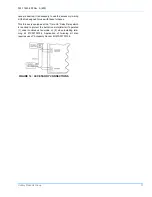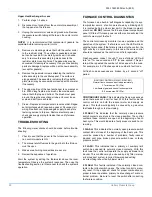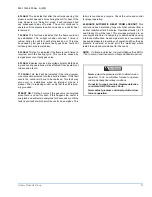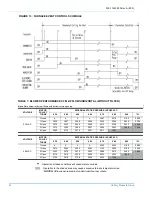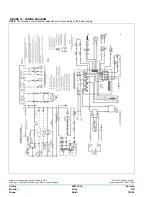
035-17443-000 Rev. A (800)
Unitary Products Group
15
ADJUSTMENT OF MANIFOLD GAS PRESSURE
1.
Turn gas off at main gas valve. Remove 1/8" plug/outlet
pressure tap in the main gas valve body and install
proper manometer tube adapter fitting. Connect line from
gas valve tap to manometer.
2.
Refer to Figure 10 on page 15 for location of outlet pres-
sure. Tap pressure regulator adjustment cap and screw
on main gas valve.
NOTE:The screw-off cap for the pressure regulator must be
removed entirely to gain access to the adjustment screw.
3.
Turn gas and electrical supplies ON. Turn gas valve
switch to “ON” position. Start furnace and observe mani-
fold pressure on manifold.
4.
If necessary, adjust manifold pressure by adjusting gas
valve regulator screw to agree with Table 6 values.
It may be necessary to re-adjust the gas valve inlet pressure
(see Table 4 for values) using a similar procedure but using
the inlet pressure tap on valve - adjust line regulator.
If gas valve regulator is turned in, or clockwise, manifold
pressure is increased. If screw is turned out, or counterclock-
wise, manifold pressure will decrease.
FIGURE 10 : GAS VALVES
TOP - WHITE-RODGERS 36F52-252
BOTTOM - HONEYWELL VR8205
TABLE 5: GAS RATE (CUBIC FEET PER HOUR)
S
ECONDS
FOR
S
IZE
OF
T
EST
D
IAL
O
NE
R
EVOLUTION
1/2
CUBIC
FOOT
1
CUBIC
FOOT
10
180
360
12
150
300
14
129
257
16
113
225
18
100
200
20
90
180
22
82
164
24
75
150
26
69
138
28
64
129
30
60
120
32
56
113
34
53
106
36
50
100
38
47
95
40
45
90
42
43
86
44
41
82
46
39
78
48
37
75
50
36
72
52
35
69
54
34
67
56
32
64
58
31
62
60
30
60
Be sure to relight any gas appliances that were
turned off at the start of this input check.
The cap must be replaced in order for the furnace
to operate properly.
TABLE 6: MANIFOLD PRESSURE
Natural Gas
3.5" W.C.
Propane (LP)
10.0" W.C.
The manifold pressure must be checked with the
screw-off cap in place on the pressure regulator.
If manifold pressure is too high, an over-fire condi-
tion exists which could cause heat exchanger fail-
ure. If the manifold pressure is too low, sooting
and eventual clogging of the heat exchanger could
occur.

















